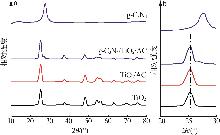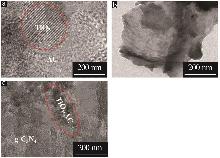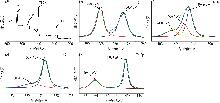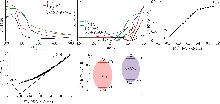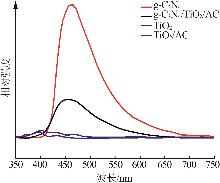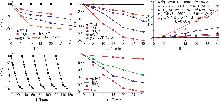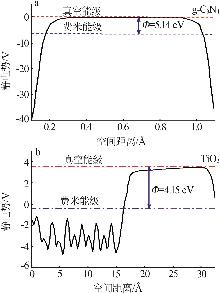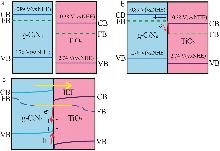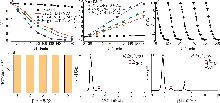Inorganic Chemicals Industry ›› 2025, Vol. 57 ›› Issue (4): 118-127.doi: 10.19964/j.issn.1006-4990.2024-0351
• Catalytic Materials • Previous Articles Next Articles
Degradation performance analysis of S-scheme activated carbon supported g-C3N4/TiO2 photocatalytic concrete
- Architectural Engineering Institute,Puyang Vocational and Technical College,Puyang 457000,China
-
Received:2024-06-21Online:2025-04-10Published:2024-07-17
CLC Number:
Cite this article
ZHANG Dian. Degradation performance analysis of S-scheme activated carbon supported g-C3N4/TiO2 photocatalytic concrete[J]. Inorganic Chemicals Industry, 2025, 57(4): 118-127.
share this article
| [1] | JOHNSTON A L, LESTER E, WILLIAMS O,et al.Impacts of multi-pollutants on sulfonamide antibiotic removal from water matrices using layered double hydroxide sorbents[J].Environmental Technology & Innovation,2024,33:103490. |
| [2] | SIVANATHAN M, KARTHIKEYAN B.Phenylalanine self-assembled nanotubes intercalated sol-gel silica membrane for synergetic removal of harmful chromium and dye particles:Assembling,probing and novel photocatalytic recycling[J].Journal of Water Chemistry and Technology,2022,44(6):476-481. |
| [3] | DUTTA K, SHERLEY SARAFFIN R, DUTTA B,et al.Room temperature synthesis of GO/Ag2O nanocomposite:Broad spectral ranged solar photocatalyst and high efficacy antibiotic for waste water treatment[J].Journal of Environmental Chemical Engineering,2022,10(2):107175. |
| [4] | WANG Jingquan, ZHANG Weijun, WU Huan,et al.Hydrothermal supramolecular preorganization synthesis of multi-morphological g-C3N4/Fe2O3 for photocatalytic removal of indoor formaldehyde under visible light[J].Journal of Environmental Chemical Engineering,2023,11(2):109395. |
| [5] | ZHU Qian, ZHUANG Yan, ZHAO Hongqing,et al.2,5-Diformylfuran production by photocatalytic selective oxidation of 5-hydroxymethylfurfural in water using MoS2/CdIn2S4 flower-like heterojunctions[J].Chinese Journal of Chemical Engineering,2023,54:180-191. |
| [6] | VERMA S, KUMAR N, KIM K H,et al.Photocatalytic efficacy of air purifiers equipped with self-cleaning titanium dioxide xerogel coatings against gaseous formaldehyde:A study using DRIFTS and DFT analysis[J].Chemical Engineering Journal,2024,486:150269. |
| [7] | 朱佳新,熊裕华,郭锐.二氧化钛光催化剂改性研究进展[J].无机盐工业,2020,52(3):23-27,54. |
| ZHU Jiaxin, XIONG Yuhua, GUO Rui.Research progress in modification of TiO2 photocatalyst[J].Inorganic Chemicals Industry,2020,52(3):23-27,54. | |
| [8] | POURSHIRBAND N, NEZAMZADEH-EJHIEH A, MIRSATTARI S N.The CdS/g-C3N4 nano-photocatalyst:Brief characterization and kinetic study of photodegradation and mineralization of methyl orange[J].Spectrochimica Acta Part A:Molecular and Biomolecular Spectroscopy,2021,248:119110. |
| [9] | 陈彰旭,朱丹琛,傅明连.g-C3N4/TiO2复合材料制备及其处理罗丹明B研究[J].无机盐工业,2023,55(7):130-136. |
| CHEN Zhangxu, ZHU Danchen, FU Minglian.Study on preparation of g-C3N4/TiO2 composites and application for rhodamine B removal[J].Inorganic Chemicals Industry,2023,55(7):130-136. | |
| [10] | KHUDHAIR E M, AMMAR S H, AL-NAJJAR S Z,et al.Facile construction of g-C3N4/MnWO4/NiS heterostructures for photocatalytic degradation of organic contaminates under visible light irradiation[J].Materials Letters,2023,347:134599. |
| [11] | MENG Deqin, GAO Sihang, CHENG Ziqi,et al.Study on CuO/g-C3N4 S-scheme heterojunction for enhanced visible-light-driven photocatalytic degradation of xanthate[J].Optical Materials,2023,143:114259. |
| [12] | 刘思乐,卜义夫,吴静,等.非均相Pd/mpg-C3N4催化糠醛选择性加氢制糠醇[J].化学工程,2022,50(12):22-26,55. |
| LIU Sile, BU Yifu, WU Jing,et al.Selective hydrogenation of furfural to furfuryl alcohol catalyzed by heterogeneous Pd/mpg-C3N4 [J].Chemical Engineering(China),2022,50(12):22-26, 55. | |
| [13] | 孙海杰,程圆,田源,等.BiOI/g-C3N4催化剂的制备及其光催化降解罗丹明B性能[J].无机盐工业,2023,55(8):36-44. |
| SUN Haijie, CHENG Yuan, TIAN Yuan,et al.Preparation of BiOI/g-C3N4 catalyst and its photocatalytic degradation performance of rhodamine B[J].Inorganic Chemicals Industry,2023,55(8):36-44. | |
| [14] | 梁发文,官海汕,李江鸿,等.非金属掺杂改性g-C3N4光催化降解水中有机污染物的研究进展[J].人工晶体学报,2023,52(1):170-181. |
| LIANG Fawen, GUAN Haishan, LI Jianghong,et al.Research progress on photocatalytic degradation of organic pollutants in water by nonmetal doping modified g-C3N4 [J].Journal of Synthetic Crystals,2023,52(1):170-181. | |
| [15] | 唐贝.ZnO/g-C3N4异质结光催化材料的制备及对吡啶的降解[J].无机盐工业,2024,56(4):133-142. |
| TANG Bei.Preparation of ZnO/g-C3N4 heterojunction photocatalytic material and its degradation of pyridine[J].Inorganic Che- | |
| Industry micals,2024,56(4):133-142. | |
| [16] | YUAN Fei, ZHENG Yufei, GAO Dengzheng,et al.Facile assembly and enhanced visible-light-driven photocatalytic activity of S-scheme BiOBr/g-C3N4 heterojunction for degrading xanthate in wastewater[J].Journal of Molecular Liquids,2022,366:120279. |
| [17] | MO Xiaojie, ZHANG Xiaohan, LIN Biyun,et al.Boosting interfacial S-scheme charge transfer and photocatalytic H2-production activity of 1D/2D WO3/g-C3N4 heterojunction by molecular benzene-rings integration[J].Journal of Materials Science & Technology,2023,145:174-184. |
| [18] | BASELY A M, SHAKER M H, HELMY F M,et al.Construction of Bi2S3/g-C3N4 step S-scheme heterojunctions for photothermal decomposition of rhodamine B dye under natural sunlight radiations[J].Inorganic Chemistry Communications,2023,148:110300. |
| [19] | SHANG Yanyan, FAN Huiqing, CHEN Yanqin,et al.Synergism between nitrogen vacancies and a unique electrons transfer pathway of Ag modified S-scheme g-C3N4/CdS heterojunction for efficient H2 evolution[J].Journal of Alloys and Compounds,2023,933:167620. |
| [20] | 贺晓宇.基于氮化碳的光催化水泥混凝土制备与性能研究[J].公路,2020,65(10):292-296. |
| HE Xiaoyu.Preparation and properties of photocatalytic cement concrete based on carbon nitride[J].Highway,2020,65(10):292-296. | |
| [21] | 吴林松,王星之,梅梦君,等.TiO2透水混凝土配合比设计和光催化性能[J].长江科学院院报,2023,40(12):188-192. |
| WU Linsong, WANG Xingzhi, MEI Mengjun,et al.Mix proportion design and photocatalytic performance of TiO2 modified pervious concrete[J].Journal of Changjiang River Scientific Research Institute,2023,40(12):188-192. | |
| [22] | 季雨晴,傅敏,杨凌,等.硅藻泥/TiO2/g-C3N4光催化涂料的制备及净化NO性能研究[J].现代化工,2021,41(2):172-176, 182. |
| JI Yuqing, FU Min, YANG Ling,et al.Preparation of diatom mud/TiO2/g-C3N4 photocatalytic coatings and its purification performance to NO[J].Modern Chemical Industry,2021,41(2):172-176,182. | |
| [23] | AHMADPOUR N, SAYADI M H, HOMAEIGOHAR S.A hierarchical Ca/TiO2/NH2-MIL-125 nanocomposite photocatalyst for solar visible light induced photodegradation of organic dye pollutants in water[J].RSC Advances,2020,10(50):29808-29820. |
| [24] | SHI Shuo, JIA Mingmin, LI Meisheng,et al.ZnO@g-C3N4 S-scheme photocatalytic membrane with visible-light response and enhanced water treatment performance[J].Colloids and Surfaces A:Physicochemical and Engineering Aspects,2023,667:131259. |
| [25] | AHMAD K, KHAN M Q, ALSALME A,et al.Sulfur-doped graphitic-carbon nitride(S@g-C3N4) as bi-functional catalysts for hydrazine sensing and hydrogen production applications[J].Synthetic Metals,2022,288:117100. |
| [26] | CAUDILLO-FLORES U, RODRÍGUEZ-PADRÓN D, MUÑOZ-BATISTA M J,et al.Facile synthesis of B/g-C3N4 composite materials for the continuous-flow selective photo-production of acetone[J].Green Chemistry,2020,22(15):4975-4984. |
| [27] | YANG Lang, YING Jialei, LIU Zhenzhong,et al.Synthesis of 1D magnetic Fe3O4@SiO2/TiO2 nanostir bar photocatalyst for the degradation of MB under UV light[J].Materials Letters,2024,364:136344. |
| [28] | PAULISTA L O, FERREIRA A F P, RODRIGUES A E,et al.Solar thermo-photocatalytic methanation using a bifunctional RuO2:TiO2/Z13X photocatalyst/adsorbent material for efficient CO2 capture and conversion[J].Journal of Environmental Chemical Engineering,2024,12(3):112418. |
| [29] | MA Zhanqiang, GUO Wei, ZHANG Kaiyue,et al.Liquid exfoliation of bulk g-C3N5 to nanosheets for improved photocatalytic antibacterial activity[J].Environmental Science and Pollution Research International,2023,30(26):69486-69498. |
| [30] | CHELLAPANDI T, MADHUMITHA G, ROOPAN S M,et al.Facile synthesis route for visible active g-C3N5/MK30 nanocomposite and its computationally guided photocatalytic degradation of organic pollutants[J].Separation and Purification Technology,2023,307:122865. |
| [31] | HASSAN H M U, TAWAB S A, KHAN M I,et al.Reduce the recombination rate by facile synthesis of MoS2/g-C3N4 heterostructures as a solar light responsive catalyst for organic dye degradation[J].Diamond and Related Materials,2023,140:110420. |
| [32] | JIANG Xiaodong, XU Changhai, DU Jinmei,et al.PVDF-based nanofiber membrane decorated with Z-scheme TiO2/MIL-100(Fe)heterojunction for efficient oil/water emulsion separation and dye photocatalytic degradation[J].Colloids and Surfaces A:Physicochemical and Engineering Aspects,2024,688:133605. |
| [33] | 马润东,郭雄,施凯旋,等.MoS2/g-C3N4 S型异质结的构建及光催化性能研究[J].无机材料学报,2023,38(10):1176-1182. |
| MA Rundong, GUO Xiong, SHI Kaixuan,et al.S-type heterojunction of MoS2/g-C3N4:Construction and photocatalysis[J].Journal of Inorganic Materials,2023,38(10):1176-1182. | |
| [34] | GRAIMED B H, JABBAR Z H, ALSUNBULI M M,et al.Decoration of 0D Bi3NbO7 nanoparticles onto 2D BiOIO3 nanosheets as visible-light responsive S-scheme photocatalyst for photo-oxidation of antibiotics in wastewater[J].Environmental Research,2024,243:117854. |
| [35] | SHI Suili, LIU Zhenkun, MIAO Xinyu,et al.Broad-spectrum absorptive ZnCr LDHs/ZIF-67 S-scheme heterojunction for hydrogen evolution reaction under visible light irradiation[J].Journal of Photochemistry and Photobiology A:Chemistry,2024,455:115768. |
| [1] | CUI Lipeng. Synthesis of AgBr/C3N5 inorganic photocatalytic coating for concrete and degradation of HCHO [J]. Inorganic Chemicals Industry, 2025, 57(4): 128-136. |
| [2] | SHI Wangfang, ZHANG Yongsheng. Study on NO x degradation performance of concrete-based non-metallic boron doped nitrogen-rich carbon nitride [J]. Inorganic Chemicals Industry, 2025, 57(3): 116-123. |
| [3] | LI Zihan, ZHANG Jiaqi, LI Shizhuo, LI Xinyu, LIU Shaozhuo, WANG Yihao, HAO Yucui, LIU Jian, LI Yanhua. Study on synthesis and catalytic mechanism of CdS/g-C3N4 composite photocatalyst [J]. Inorganic Chemicals Industry, 2025, 57(3): 124-132. |
| [4] | MAO Shize. Study on microwave roasting-activated coal gangue to improve sulfate corrosion resistance of concrete [J]. Inorganic Chemicals Industry, 2025, 57(3): 86-93. |
| [5] | SUN Qinghao, LI Keyan, GUO Xinwen. Study on photocatalytic benzyl alcohol oxidation coupled with hydrogen production over Pd/ZnIn2S4 nanosheets [J]. Inorganic Chemicals Industry, 2025, 57(1): 113-119. |
| [6] | LIU Guangming. Study on photocatalytic and mechanical properties of C3N5/NH2-MIL-125(Ti) modified concrete mortar [J]. Inorganic Chemicals Industry, 2025, 57(1): 120-128. |
| [7] | ZHANG Feigang, LIU Zhongli. Study on application of CuO/g-C3N4 composites in organic dye degradation and supercapacitors [J]. Inorganic Chemicals Industry, 2025, 57(1): 129-136. |
| [8] | SUN Yanlong, YUAN Guangsheng, WANG Hongjun. Study on palladium modified mesoporous TiO2 nanorods for efficient photodegradation of tetracycline [J]. Inorganic Chemicals Industry, 2024, 56(9): 147-153. |
| [9] | LIU Cijun, WU Ziyang, CHENG Shukai, CHEN Xuyong. Effect of recycled fine aggregate on mechanical properties and autogenous shrinkage of ultra-high performance concrete [J]. Inorganic Chemicals Industry, 2024, 56(9): 75-81. |
| [10] | ZHANG Guoqiang, RONG Xilin, XIAO Zhenfang, XUE Ziran, CHENG Hao, FENG Jun, LIU Quan, LU Yao, HUANG Wenyi. Study on preparation and photocatalytic properties of bagasse carbon aerogels loaded with zinc oxide nanoparticles [J]. Inorganic Chemicals Industry, 2024, 56(8): 131-138. |
| [11] | ZHANG Ruijun, CHEN Guoliang, SONG Chuncao, ZHU Yafei. Effects of graphene oxide on mechanical properties and chloride penetration resistance of ultra⁃high performance concrete incorporating recycled sand [J]. Inorganic Chemicals Industry, 2024, 56(8): 54-59. |
| [12] | WANG Yawen, WANG Fangfang, GENG Siyu, JU Jia, CHEN Lei, CHEN Changdong. Study on preparation and photocatalytic performance of SrTiO3-SrWO4 [J]. Inorganic Chemicals Industry, 2024, 56(7): 143-149. |
| [13] | LIU Min, HUANG Xiu, ZHANG Liyuan. Research progress of S-type heterojunction photocatalysts [J]. Inorganic Chemicals Industry, 2024, 56(7): 18-27. |
| [14] | YE Fen, CHENG Hao, XIANG Yuan, LIU Song, SHI Wei. Preparation of ceramic aggregate from electrolytic manganese slag and its application in concrete [J]. Inorganic Chemicals Industry, 2024, 56(6): 127-132. |
| [15] | LI Jiangpeng, ZHANG Huibin. Synergistic degradation of methylene blue by photo-Fenton and photocatalytic with 3D porous LaFeO3/CeO2/SrTiO3 [J]. Inorganic Chemicals Industry, 2024, 56(5): 141-148. |
| Viewed | ||||||
|
Full text |
|
|||||
|
Abstract |
|
|||||
|
||

